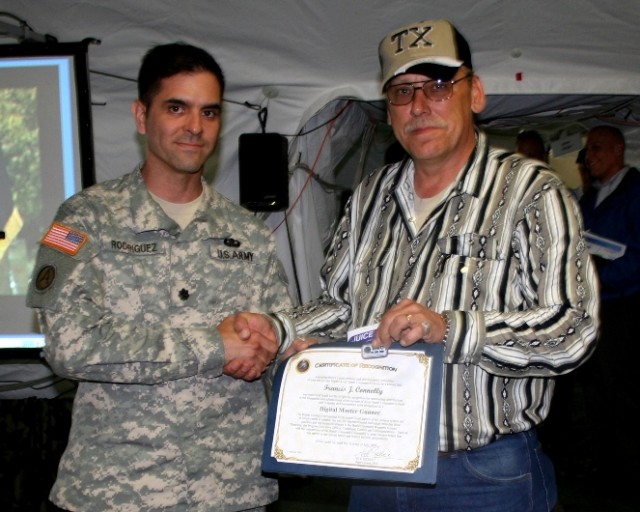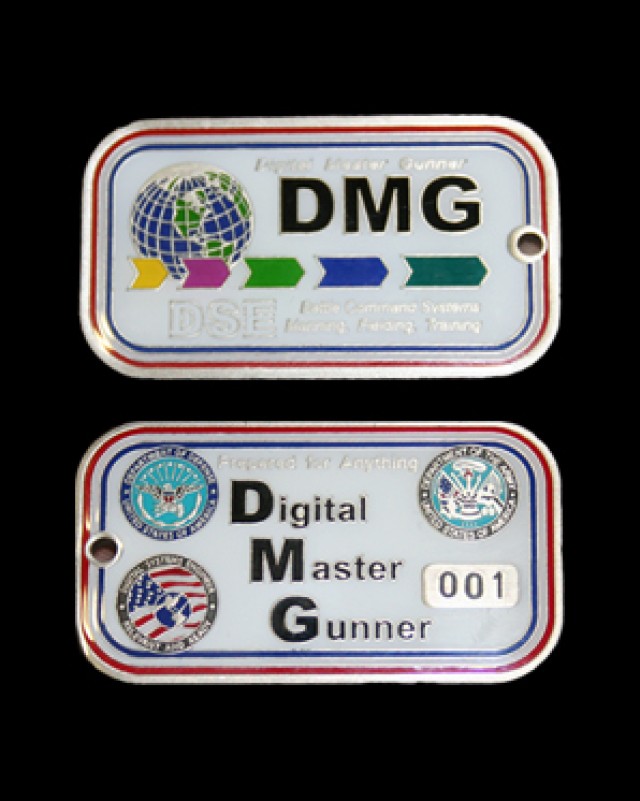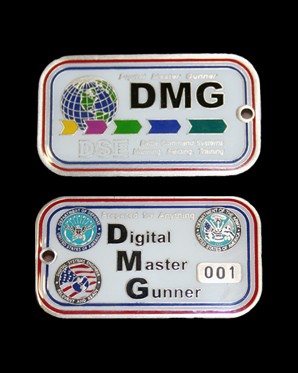FORT MONMOUTH, N.J. - The Battle Command and Network Support Directorate (BCNSD) employs digital systems engineers (DSEs) to support brigade combat teams that are fielded with Army Battle Command Systems. With their wealth of experience and training, digital master gunners (DMGs) bring an even higher caliber of support to the BCNSD.
"Digital Master Gunners are at the top of the pyramid in terms of field support," said Lt. Col. Michael Rodriguez, director of the BCNSD. "They don't just know how to operate and employ one system, they understand the system of systems for all of the systems that we field."
In honor of being the first person to make it through the DMG certification board, Frank Connolly was presented with the first DMG coin and a DMG award certificate. Connolly is Regional Lead Digital Systems Engineer for the 407th AFSB CONUS West. Maj. Gen. Nick Justice, Program Executive Officer for Command, Control, Communications-Tactical (PEO C3T) made the presentation.
Connolly received the recognition on June 5 in the PEO C3T tent at the Joint User Interoperability Communications Exercise (JUICE) site in Fort Monmouth, N.J.
"I have the very first Digital Master Gunner coin to give to you, Frank," Justice said. "You've been running and carrying us for a long time. Thank you for all that you've done."
DSEs troubleshoot, mentor and provide over-the-shoulder training in both training and field environments. Most have prior military service and have been Soldiers in Tactical Operation Centers (TOCs) with the systems that they are supporting. This enables them to "bring a wealth of background information and holistic field support to the fight," Rodriguez said.
"They have a connection to the Soldier and they understand what the Soldier needs from the systems," Rodriguez said.
"A digital master gunner goes out into a TOC and walks the Soldiers through all of the common hardware and the Army battlefield systems, and he shows them how to use it and how they are relevant to the fight," Connolly said.
To receive the DMG certification, the DSE must receive extensive training and stand before a formalized board, similar to a promotion board. Currently, there are only 12 DMGs of the 125 Digital Systems Engineers (DSEs) supporting PEO C3T and Team C4ISR, Connolly said. The DMG guides training and mentors the newer DSEs.
Although Connolly was the first person to receive DMG certification, he is just now receiving his coin. The number 001 in the series was saved for him.
As a retired Sergeant First Class currently assigned to Fort Hood, Texas, Connolly brings decades of both tactical and operational experience to the mission, Rodriguez said. He's been on multiple deployments, both in Afghanistan and Iraq, and he's been to all of the Army's training centers and carries that experience back with him.
Connolly also knows how the systems must be networked, how the Soldier will use the systems and what the commander needs from the systems, Rodriguez said.
Connolly served 24 years in the Army and then became a contracted field support representative (FSR). He said that DSEs serve an important purpose, especially with the rapid turnaround of today's forces. They offset the continual turnover by remaining a constant source of information and support that keeps a command from having to start from scratch each time Soldiers are rotated in and out.
"You get the biggest bang for the buck that way, because you are not starting over every time," Connolly said.
"We're relevant to the fight," Connolly said. "I am there for the commander. I am there for the staff to assist them in accomplishing their mission. It is a lot of effort that you have to put forward, but the biggest thrill is watching the guys in the field."
DSEs provide field support and have an expansive knowledge of all fielded Army Team C4ISR systems. The DSE works side-by-side with the Soldier, and if any issues arise, he is on-site to help and offer suggestions. When the DSE cannot resolve an issue, he will contact a higher tier representative who will dispatch a FSR.
Each brigade combat team includes an embedded DSE in theater. Any issues that the brigade-level DSE cannot resolve are given to the division-Level DSE. During a unit's training exercise, the DSEs help resolve issues and set priorities, repair boxes, provide some over-the-shoulder training and explain systems. Many deploy to support the same unit in Iraq or Afghanistan.
"No commander wants to lose a Soldier, so if there is something we can provide to the Soldier to assist the commander in making decisions; then I've done my job," Connolly said.




Social Sharing